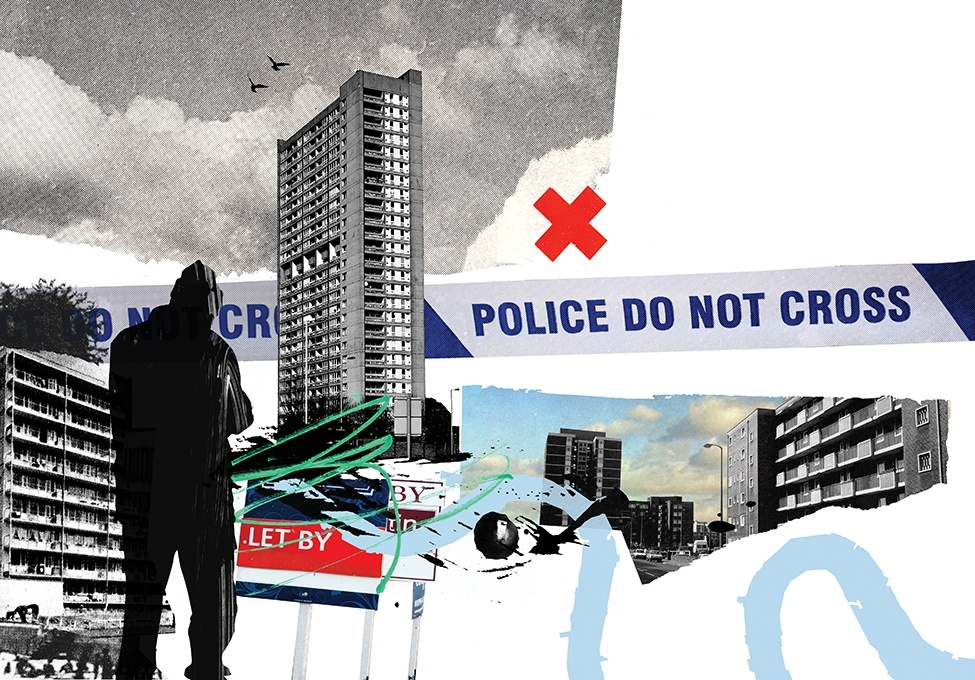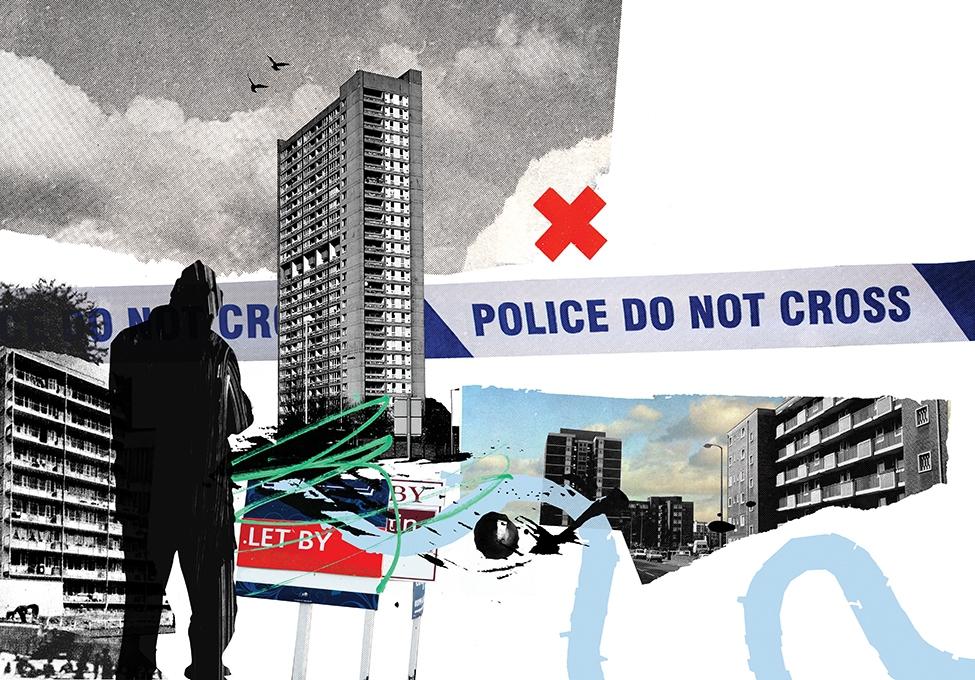You are viewing 1 of your 1 free articles
Crime wave
A crime writer challenges social landlords to do more to tackle brothels and ‘trap houses’ on estates. Michael Lloyd reports
Video:
features code

Graham Johnson thought he knew all about crime on south London’s housing estates, until he started investigating the beheading of soldier Lee Rigby on a Woolwich street in 2013.
Mr Johnson, a veteran crime journalist and author of true crime books, was digging for background about one of the murderers, Michael Adebolajo. He noticed two things.
“A council official is getting paid a wage, a pension and benefits to do this job and it is not being done”
Graham Johnson, true crime writer
“One - it was difficult to find out where he had lived because he had been in a string of council properties, which were either sub-let to him or he was living there as an unauthorised resident. Number two - when I went onto the estates where these houses were, I noticed that lots of the council houses had been turned into basically gang houses,” he explains.
He found cannabis farms, and trap houses (where drugs are sold and gangs hide out). Then there were brothels. “When I started off as a crime reporter on News of the World many years ago, most of the brothels and massage parlours were based in commercial properties, you know, above shops, on the high street… but all of these ones that I was coming across were in council properties.”
Video:
Ad slot
Mr Johnson had visited the estates frequently, chasing stories. But he sensed they had changed for the worse. He uncovered truly shocking scenes, the basis for two documentaries he made for the Vice website. He was especially disturbed that so much crime could go undetected, in publicly-owned property.
He believes that social landlords are asleep at the wheel. “I’m not a housing expert but it is someone’s job - a council official is getting paid a wage, a pension and benefits to do this job and it is not being done,” Mr Johnson asserts.
Is he right? And what can be done to deal with the kinds of crime he identifies?

Source: Rex Features
Crime writer Graham Johnson unearthed criminal activity connected to sub-letting
Mr Johnson believes that the roots of crime on estates lie in illegal sub-letting. It is not that illegal sub-lets are all run by criminals - but that an illegally-let house is perfect for gangsters.
Many criminologists agree, but unfortunately there is no hard evidence about how widespread illegal sub-lets are, nor their use by gangs.
According to Professor Mark Button, director of the Centre for Counter Fraud Studies at the University of Portsmouth, detailed figures are lacking. “It is a big problem and there are regional differences because London is going to be far worse than, say, the North East of England.
“Figures for crimes based in housing are collected locally, if at all.”
Professor John Flint, Sheffield University
“There is not enough research being done to have a really accurate picture. We have guesstimates of varying validity,” Professor Button explains.
One guesstimate, from credit ratings agency Experian, put the number of illegal sub-lets in England and Wales at 160,000 in 2012.
Other researchers, such as specialist fraud investigators BBFI, think the true figure is much higher. Professor Button notes that available statistics are only for detected fraud - and much goes undetected.
Lack of data
Professor John Flint of Sheffield University, who has investigated social housing crime and anti-social behaviour, says: “I am not aware of specific work being done from a housing perspective on these issues and to my knowledge the Department of Communities and Local Government (DCLG), for example, hasn’t commissioned work on this or indeed anti-social behaviour.”
He notes: “Figures for crimes based in housing are collected locally, if at all.”
“I could take you into schemes where it’s really bad. It’s a battle.”
Chris Grose, head of the housing advisory service, Capsticks
Inside Housing asked the Ministry of Justice, police forces and the UK national crime agencies for social housing-based crime figures - but this is not an official category. There are statistics for the types of crime that take place in residential properties, for instance cannabis farms, but these are not broken down by tenure.
Even without hard figures, analysts agree there is considerable anecdotal evidence. Chris Grose, head of the housing advisory service at law firm Capsticks, believes that while good work to fight crime goes on, it is far from being beaten. “I could take you into schemes where it’s really bad. It’s a battle,” he says.
So what can be done? Mr Grose believes UK housing providers have the tools they need to work with the police and other agencies to bring crime under control. He thinks the Anti-social Behaviour, Crime and Policing Act of 2014 has helped. “The reform was all about partnership working,” he adds.
Sharing information between social landlords and the police helps both partners, Mr Grose believes, but their roles are different. “Crime is crime and that needs to be dealt with, ultimately, by the police,” he says.
Eamon Lynch, head of governance at anti-social behaviour advisor Resolve, agrees that cooperation is at the heart of joint-working and relationships are mainly good.
“There are variations, of course. There might be an arrangement with the local police force whereby sharing information is handled centrally and that leads to different interpretations as to what can be shared locally - and to delays.”
“You’ve got to take your hat off to them because they could potentially be exposing themselves to real risk.”
Eamon Lynch, head of governance, Resolve
Mr Lynch believes building trust with tenants is key. Sometimes a tenant who pesters the housing office over trivia can provide crucial evidence for detecting criminality. “They might be reporting 10 or 20 things that are not valuable, but every now and again there will be a real nugget. You’ve got to take your hat off to them because they could potentially be exposing themselves to real risk.”
Risk there certainly is. And it isn’t just ‘snitches’ that are subject to intimidation - preying on tenants can be how the criminals gain their illegal sub-lets, according to crime writer Mr Johnson.
“For instance, I was told by a gang member what they would do if there was an old lady there or someone vulnerable, they would start off by saying, “listen love, can I charge my phone?” And then she’d be intimidated or too disorganised to say no and once they’re in there it becomes: ‘Can you mind this for us?’ and eventually they do what they like or bully them out.
“Or with young people, they would get them onside with a small amount of drugs and money to use the place. Or they would get the council property by telling lies to the council.”
Mr Grose agrees bullying and intimidation are hard to prevent, but social landlords can make it easier for their tenants to report crime. “I think ultimately it depends on results. If people can’t see that issues are being tackled, then they think what’s the point and are reluctant to report.”
Experts point to examples such as Project Solace, where 4,500-home Gloucester City Homes works in direct partnership with the police to investigate complaints.
Thirty-eight-thousand-home Sovereign Housing Association, meanwhile, radically overhauled its communications strategy to gain the confidence of 80% of the community, up from around half. Then there is 12,000-home Stockport Homes, which remodelled its service to provide more intervention officers which work with perpetrators to change their behaviour.
Proactive liaison
As a large city council with many estates, Birmingham is taking a proactive stance in building relationships with its tenants. It carries out an annual tenancy visit to get inside all of its 62,819 properties.
“Part of the visit includes exploring issues concerning crime and anti-social behaviour issues. These visits also provide an opportunity for any affected tenants to provide intelligence directly to council officers for further investigation,” a spokesperson for the council tells us.
These efforts at symptom control are replicated hundreds of times across the UK, but what about digging to the roots of the rot, in illegal sub-letting? Southwark Council is piloting a web-based approach to reporting tenancy fraud, which may pay dividends (see box: Southwark’s tenancy fraud checker).
Southwark’s tenancy fraud checker
Southwark has developed a dedicated website, ‘ilatch’, where prospective private tenants can find out whether they are being offered an illegally sub-let council house.
By inputting a postcode they can see if it is council stock.
They are encouraged to provide details about their searches, which are passed to the council’s anti-fraud team. So far, 144 scams have been detected. The system is one of a range of measures Southwark uses to combat housing fraud, including document scanning and credit checks.
Other UK local authorities are in talks with Southwark about using the ilatch system.
The council’s website allows concerned residents to pass on details of suspected fraud for investigation. Southwark though, has recently been the target of a serious tenancy fraud case, in which one of its own homelessness officials faked 23 housing applications.
So are the efforts being made sufficient? The DCLG insists that it is concerned about tenancy fraud. “That is why we brought in fines and custodial sentences for those found guilty of illegal sub-letting and provided £19m to help councils tackle the problem,” the department says.
Mr Johnson remains sceptical that housing professionals are winning. “I’m not paid to come up with the answer, but whoever is paid to isn’t doing their job. It’s not hard to find where a brothel is operating on a council housing estate - it takes about 10 minutes.”
So, Mr Johnson is challenging the social housing sector to up its game. Whether his views ring true or not, it seems that there is not much hard evidence to contradict him. Nor to show whether the sector is winning its war on social housing crime.









